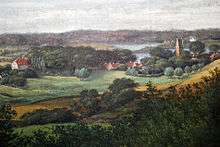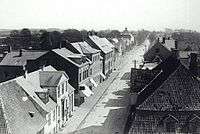Kongens Lyngby
_21-03-06.jpg)
Kongens Lyngby (Danish pronunciation: [ˈkʌŋəns ˈlyːŋby]; short forms Kgs. Lyngby or Lyngby) is the seat and commercial centre of Lyngby-Taarbæk Municipality in the northern suburbs of Copenhagen, Denmark. Lyngby Hovedgade is a busy shopping street and the site of a branch of Magasin du Nord as well as Lyngby Storcenter. The district is also home to several major companies, including COWI A/S, Bang & Olufsen ICEpower a/s.
Lyngby station is located on the Hillerød radial of Copenhagen's S-train network.
Kongens Lyngby borders: Brede; the municipality of Gentofte (the most affluent in Denmark); Sorgenfri, where the Danish Prime Minister's official residence, Marienborg, lies; and the Gladsaxe municipality.
History

The name Kongens Lyngby is first recorded in 1893. At that time large parts of North Zealand belonged to the Catholic Church (represented by Roskilde Cathedral and the name Lyngby was associated with several places. Store Lyngby belonged to Arresø church. "Our" Lyngby, on the other hand, was crown land. It may therefore have been to distinguish it from these other places that the name emerged.[1]
The original Lyngby village is now known as Bondebyen. Kongens Lyngby was also the site of a watermill, Lyngby Watermill, which is first mentioned in 1492 but is probably several hundred years older.
A royal road, Lyngby Kongevej, was created in 1584 to provide an easy link between Copenhagen and Frederick's new Frederiksborg Castle from where it was later extended to Fredensborg and Helsingør. It was the first of a number of royal roads created by Frederick II and his successor Christian IV.[2]

In the 18th century, a growing number of country houses were built in the area by civil servants and merchants from Copenhagen. Kongens Lyngby had no market rights but developed into a local service centre with an increasing number of craftsmen and merchants.[3]

The North Line came to Lyngby in 1863 and was extended to Helsingør in 1864,This enabled citizens from Copenhagen to settle permanently in the area.Several factories opened in the area, including Christian Hasselbalck's curtain factory in 1892 which later became the town's largest employer.
In the 1930s, Kongens Lyngby developed into a modern suburb. The North Line was converted into an S-train line with more stations and Kongens Lyngby gradually merged with the neighboring settlements.
Shopping
Kongens Lyngby is the important shopping destination in the northern suburbs. Lyngby Hovedgade is a busy shopping site and is the site of a Magasin du Nord as well as Lyngby Storcenter.
Notable people
- Jeanette Ottesen (born 1987), swimmer
See also
References
- ↑ "Sorgenfri Castle". lyngbyok.dk. Retrieved 21 February 2017.
- ↑ "Kongeveje" (in Danish). Gyldendal. Retrieved 21 July 2015.
- ↑ "Kommunens historie" (in Danish). Lyngby-Taarbæk Kommune. Retrieved 16 February 2017.
External links
| Wikimedia Commons has media related to Kongens Lyngby. |
| Wikivoyage has a travel guide for Lyngby. |